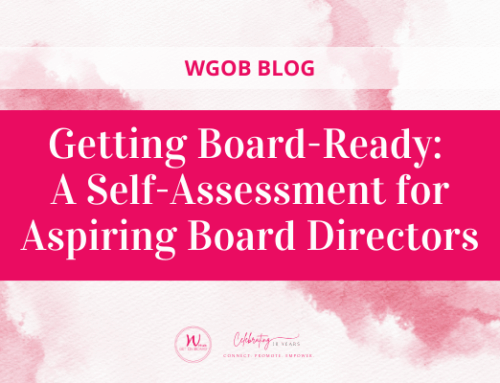By Susan Rabkin, Corporate Director, and Karen Pugliese, Country Leader, Canada, CommScope
February 11, 2019
Background
On an icy February morning, in Toronto over 75 people turned out at the Women Get On Board breakfast event hosted by Gowling WLG for a panel discussion on the board’s role in creating value and minimizing risk in M&A transactions. Norma Beauchamp moderated the panel, board member and panelists included Kathleen Ritchie, Partner, Gowling WLG and Steven Latinovich, Managing Director, Corporate Finance BMO Financial Group. From metals, mining and energy to the latest trend of international expansion of cannabis, both the number of Canadian registered deals and their value, have increased exponentially in the last couple of years. The board’s role in M&A is more important than ever.
The event panelists, all experts in various aspects of M&A, provided insights in response to thoughtful questions posed by the WGOB team. What follows are some of those insights.
1. Is the board M&A ready? Are there processes in place to evaluate an M&A deal?
A key to being “ready” is for the board to “know” the company and space within which it operates. It means not only seeing M&A opportunities but also understanding the competitive landscape and its threats. In addition to acquisitions the company may want to pursue, the board should consider whether the company itself might be a target, which could happen unexpectedly if the board doesn’t know the company well enough! How do you do this?
The panelists agreed that the board should have a formal process in place for regular M&A discussions (perhaps quarterly or annually). This includes regular management reports to the board on M&A opportunities, both buy-side and sell-side, especially for firms operating in industries impacted by rapid consolidation. According to Steven Latinovich, buy-side considerations would include determining what industries, verticals, and the purchase price would be accretive or strategically intelligent. On the sell-side, attention should be given to the strategic changes, divestitures, geographical re-alignments, and management succession plans that may be required, and within what timeframe, to make the firm most attractive to a potential buyer.
In addition to obtaining management’s perspective, the board should have generative discussions of their own regarding M&A. This may reveal opportunities that would not otherwise percolate up to the board from management, due to differing views on strategy, conflicts of interest, or concerns about job security. Involving advisors early and regularly, including leveraging free advice, will help put you ahead of the “readiness” curve, and may also increase the amount of M&A opportunities that merit board consideration.
Panelist Kathleen Ritchie emphasized that to be “ready,” the board must have mechanisms in place to reach one another quickly and have key advisors lined up in advance. Moving fast is critical when offers, letters of intent, or exclusivity issues arise. Boards must immediately assess the market and determine whether the offer is mere trolling or is legitimate. Moreover, many emerging companies are disorganized and would be hard-pressed to assemble a data room on short notice, thus getting access to the right information to make quick decisions can be challenging. Managing the cost of third-party experts can also be challenging, but having their guidance can make the difference between success and failure.
2. How do you determine whether a special committee should be formed and whether or not external advice should be sought?
Kathleen explained that efficiency is one of the main reasons for the establishment of a special committee of independent directors in the context of M&A. A special committee of the board can help narrow the focus of M&A strategy using a board and third-party experts in a smaller group setting to do the “heavy lifting” required when assessing an M&A transaction.
The special committee brings independence and objectivity. It was noted that the only legal requirement for establishing a special committee is to protect public company minority shareholders in the event of an insider bid. Nonetheless, all panelists agreed that having a committee or, at the minimum, a sub-committee, updating the broader board on M&A is prudent. The special committee may also be directly involved in M&A negotiations if management is too close to be impartial.
3. What are some of the critical M&A processes you need to set up and what is the right M&A leadership that needs to be in place?
When it comes to M&A, sometimes CFOs are lazy, and CEOs too aggressive, or sometimes they’re simply too stretched to give adequate consideration to M&A. According to the panelists, boards must have “boots on the ground” to really understand the psychology behind M&A, and to understand potential conflicts of interest within management. Boards must ensure their values reflect those of shareholders, and that they’re representing the best interests of the company.
What are some practical ways to do this? According to Kathleen Ritchie, before transactions arise, make sure contracts are centralized, clean up records, including minute books, etc. Don’t be shy about calling in advisors, as discussed earlier. If you’re on a public company board, make sure information is “locked-down,” and that only a small group is involved in the transaction. This will help avoid potential leaks, trading blackouts and regulatory investigations after the transaction is complete.
Strategic board leadership requires an honest assessment of corporate cultures and understanding whether distinct cultures can be aligned, knowing how to achieve meaningful synergies, understanding the transaction’s value proposition, and selecting the best financing options. Only by asking the right strategic questions and getting satisfactory answers is the board is well-positioned to provide the necessary leadership.
4. What are ways to review the proposed deal in the context of the company’s strategy and challenge the value creation potential of the transaction?
As noted above, seeing a path to either changing or invigorating the corporate culture of an organization in an M&A transaction is a critical determinant of its success or failure. According to Latinovich, if you can’t see such a path, “… it will be a drag on management resources and the acquisition will not be accretive”. In his words, “Culture Kills Strategy.”
He also noted that synergies lower acquisition multiples so the M&A team must be expert at extracting value from synergies and have confidence in their prowess at business integration. Also, as companies grow in size and scale, they may attract higher valuations and access to new markets and customers. He noted some methods to review a proposed deal both from the buy-side and sell-side and pointed out that the board’s judicious use of financing options can help a company grow more rapidly. Asking the right strategic questions, understanding your valuation and the motivations of strategic vs. financial buyers will have different implications on the legacy of the business you’ve built as a board.
5. What are some of the critical aspects of due diligence that should be in place before approving the transaction?
The panelists agreed that knowing what you’re trying to buy is the starting point for making sure you get what you want from your due diligence process. Moreover, as Ms. Beauchamp noted, finding the “skeletons in the closet,” i.e. what you don’t want to buy, is equally important. Therefore, due diligence spans not only legal, but also financial, tax, geographical access, IP, specific industries, employment matters, and many other aspects. Most M&A law firms have checklists that assist in conducting thorough due diligence, but the amount and depth of inquiry depend very much on the deal that is desired.
When a public company is involved and a deal announced, the parties must move quickly. Having the fewest conditions possible to be able to close the deal is critical. It is essential to identify items such as change of control provisions in contracts that can impact the deal’s value (e.g. debt acceleration or employment contract payouts) and to know what consents or regulatory approvals are required to complete the transaction. Share deals require reciprocal due diligence. Public searches, including on the various forms of security should be conducted to find hidden issues. The board should ask its M&A lawyers to provide an overview of the transaction and raise any “red flags” to focus the due diligence effort.
Having good bankers and sound financial advice can be pivotal for successful M&A. Due diligence conducted by these experts will help ensure that financial statements, growth trajectories, tax implications, and other qualitative aspects of a transaction are validated, and help determine the appropriate structure of a transaction.
6. What are ways to examine the post-merger integration plan in details and tracking performance against the plan?
The panelists stressed that having a post-merger plan in place is essential for several reasons. The performance of post-merger integration is tied to being able to effectively communicate the path forward, the culture, and treatment of employees. The plan will provide targets for cost savings and revenue and earnings growth, to which management can be held accountable as part of a successful integration of the businesses. The plan will also help identify strong players that will help take the organization into the future. As a result, both the pre-plan and post-plan require a focus on the people.
In this regard, having an effective communication plan for employees is paramount, or good talent may be lost. Employees must be seen as, and treated as, the most critical assets of the organization. The first step is to “lock in” the best talent and find an exit strategy for those that don’t fit. Ensure that you have adequately compensated those who are critical to the success of the acquisition – and think of success at multiple levels of the organization, not just the C-suite.
Analysis of the financial impact of the post-merger transaction involves a careful deep dive into the quality of earnings and whether they have materialized, identifying any surprises that weren’t uncovered in due diligence, determining whether appropriate cash flows are realized, whether the financing options chosen were correct, and whether there are any impediments to future investments, etc.
Shareholder perception of the integration of the businesses will be carefully scrutinized, especially when the post-merger first quarter financial results are available. Post –merger results will be the test of whether the transaction delivered the goals stated when the deal was announced.
Finally, an important caution raised by the panel. It is critical to avoid “gun jumping.” Gun jumping is the integration of the businesses before the transaction has closed. The excitement around a deal within the organization may lead to improper integration activities, with serious repercussions. Board leaders, with the help of external advisors, must ensure this does not happen.
Women Get On Board is a leading member-based company that connects, promotes and empowers women to corporate boards. We do this through an engaged community of women and men in Canada committed to advancing gender diversity in the boardroom.






